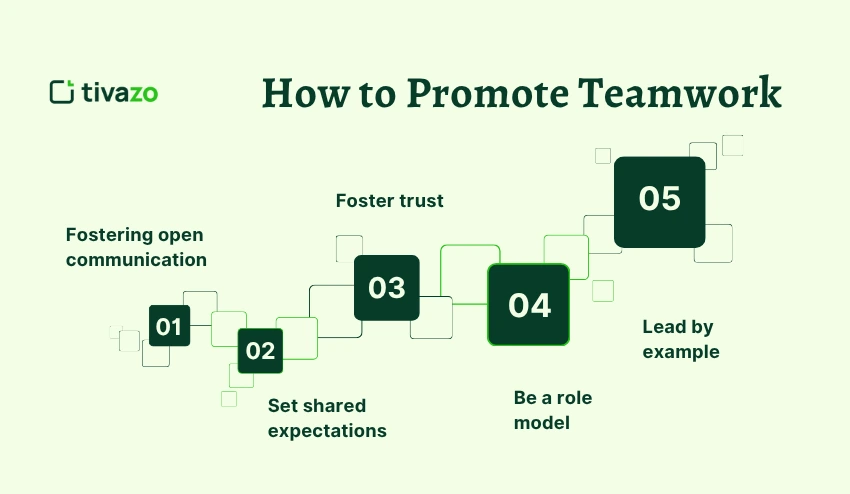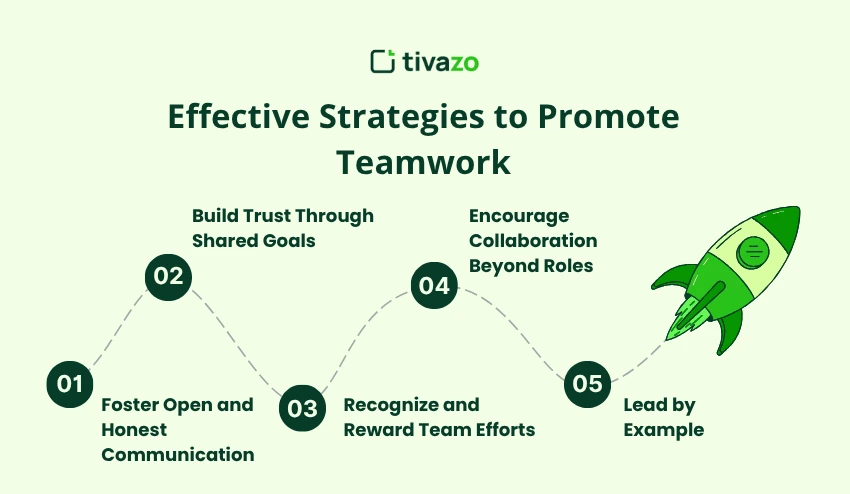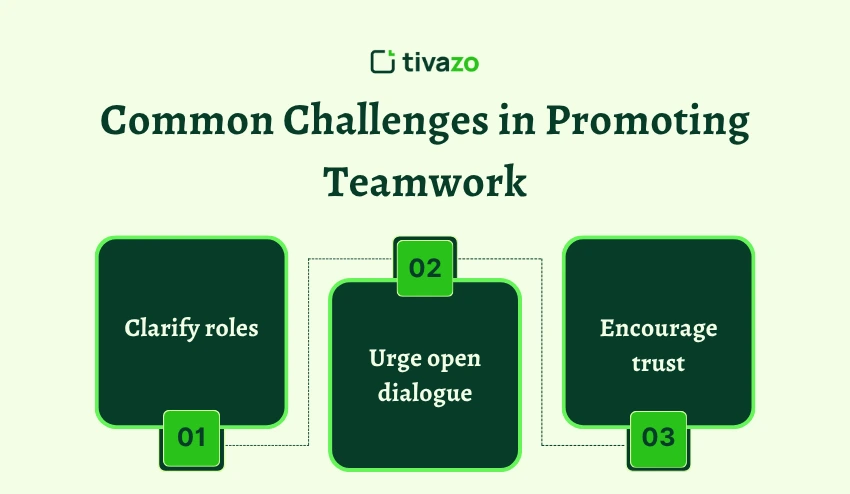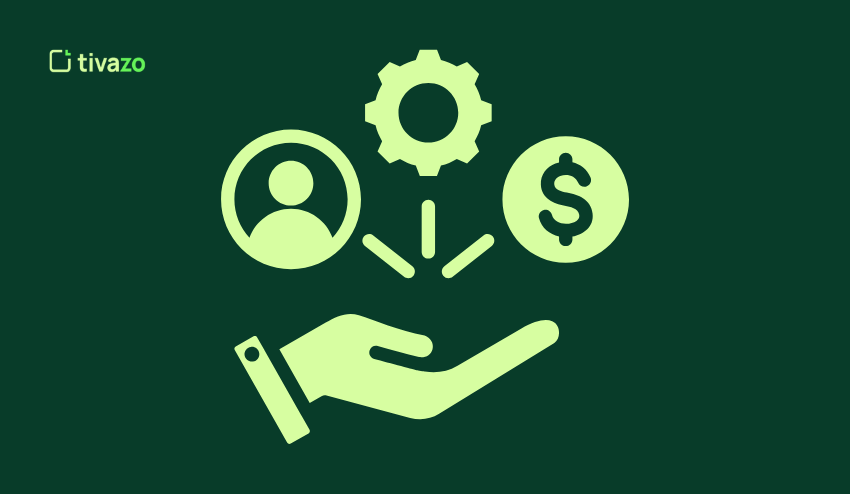In a fast-moving workplace, teamwork is not just a buzzword; it is the foundation upon which every successful organization is built. High-performing teams not only produce higher productivity, but, somehow, they also improve creativity and achieve higher employee engagement. Promote Teamwork, however, involves more than simply putting people together. It also requires trust, communication, and a common purpose.
Here are five simple, effective ways for promoting teamwork and collaboration within your team.
What Does It Mean to Promote Teamwork?
Teamwork is encouraging people to work together in an atmosphere with teamwork possibilities. This includes establishing an environment with trust, open communication, respect of diverse ideas, collaboration with creative problem solving and having every member of the team, regardless of experience or title, feel empowered and valued to contribute in order to achieve our mutual goals. Teamwork will not truly be encouraged until it is more than a way of assigning tasks to people, but a culture that allows the natural inclination needed to work together to be more productive.
When teamwork is genuinely encouraged, team members will want to share their best ideas and skills. A true sense of accountability for one another is created when each team member knows how their contribution benefits the teams success. Over time, this culture of working together closely builds solid relationships and high performance throughout the organization.
How to Promote Teamwork?
Promoting teamwork involves tangible actions that team leaders and team members can use to explicitly join forces by working to create a collaborative and effective teamwork state. It is about more than just delegating; it is also about developing habits, attitudes, and systems that allow individuals to work better together.

- Fostering open communication: facilitating the group to share ideas and feedback with ease.
- Set shared expectations: ensuring everyone knows the purpose of the group and their role and responsibilities to achieve the purpose.
- Foster trust: You should be consistent and fair, and supportive in all your interactions.
- Be a role model: modelling teamwork behaviours is a simple way for others to automatically cultivate that behaviour.
- Lead by example: Demonstrate teamwork behaviors so others follow naturally.
If teams regularly deploy the above strategies, the team will progress from a gathering of individuals to a group. After some time, these habits foster better collaboration, more productivity, and an overall reunion working environment where to promote teamwork is the default mode of operation to achieve success.
Effective Strategies to Promote Teamwork

1. Foster Open and Honest Communication
Communication is the foundation for effective teamwork. When your team members expects that their ideas can be shared, challenges can be brought forth, and feedback can be delivered without consequences, then a tremendous foundation of trust and shared understanding has been established. Check-in honestly through open communication such as transparency by setting up regular check ins or team meetings. Take advantage of communication platforms like Slack or Microsoft Teams, and utilize any of the many project management tools that are readily available today to facilitate free-flowing communication while also having the benefit of a permanent record.
- Weekly team meetings or daily stand-ups.
- Facilitating an open forum for discussion along with actively listening.
- Using collaborative tools to gauge communication and keep track of actual, measurable output.
- Giving constructive feedback for any input they receive.
2. Build Trust Through Shared Goals
There’s nothing that could create a bond stronger than a team working towards a common purpose or goal. When everyone understands that there is a bigger purpose than just themselves, they will be that much more willing to lean on each other and work towards a common goal. Leaders can routinely build teamwork when they establish specific, measurable team goals and help team members explain their own part in achieving their overall success. Celebrate success collectively on the journey, and send regular updates on progress to keep your team accountable.
- Set goals for the team that are specific and measurable.
- Provide the team with regular updates on progress.
- Acknowledge team wins and accomplishments.
- Connect team goals to individual purposes.
3. Recognize and Reward Team Efforts
Recognition may be one of the strongest motivators you can develop as a leader. When employees feel valued, they become more engaged and committed to the team’s success. Celebrate recognition through peer-to-peer recognition, monthly awards, or public recognition in meetings (even recognition can simply be through individual conversations, and it can make a huge difference not only in team morale, but also in the value of teamwork!); it could even be a “Thank You” and employees know that you “See” them and this goes a long way.
- Develop a peer-to-peer recognition process.
- Recognize smaller victories as well as larger ones.
- Encourage recognition of all kinds, both publicly and privately.
- Create an environment where team members recognize one another.
4. Encourage Collaboration Beyond Roles
“I believe true collaboration occurs when people move out of their roles and offer thoughts that aren’t confined to their roles. The willingness to improve, create value through composition and shared knowledge, and solve problems with different points of view all occur from people who share ideas and are collectively working toward a shared goal. In order to support collaboration, it might include lol across departments or across level of experience, building the ‘brain trust’ for the team, or organizing ‘Innovation Days’, or other engagements that encourage employees to work as teams to solve problems.
- Brainstorming sessions with cross-departmental employees.
- Feedback or brainstorming days where any team member can submit ideas.
- Support roles that promote creative collaboration.
- Pool the skills offered by diverse collaboration.
5. Lead by Example
Team leadership creates the atmosphere for how teamwork happens. If leaders act with empathy, collaborate with one another, and own their actions, team members are more likely to emulate that behavior. Get involved, provide useful feedback, and acknowledge your employees for their participation. Approach your new team with an open heart and mind, and willingness to collaborate, regardless of the positional differences. When teams witness a leader doing the behaviors they want them to exhibit, they will create the change you want and create a trusting, respectful, and collaborative environment.
- Get involved in team projects.
- Give useful and constructive feedback.
- Acknowledge people for their work.
- Engage in or model collaboration, empathy, and accountability.
Why Promoting Teamwork Matters
Promoting teamwork is more than boosting productivity it’s fostering a positive workplace culture where employees feel supported and inspired. Teams that are highly collaborative report higher levels of job satisfaction, lower levels of stress, and reduced levels of turnover than collaborative teams. Based on Gallup research, employees who consider themselves to be part of a team are 50% more likely to be engaged in their work.
- Promoting teamwork is more than boosting productivity – it’s fostering a positive workplace culture where employees feel supported and inspired. Teams that are highly collaborative report higher levels of job satisfaction, lower levels of stress, and reduced levels of turnover than collaborative teams. Based on Gallup research, employees who consider themselves to be part of a team are 50% more likely to be engaged in their work.
- Contributes to a positive workplace culture for employee support and inspiration
- Increases job satisfaction and reduces stress
- Promotes employee retention and loyalty
- Enhances engagement based on Gallup data, team members will be 50% more engaged than non-team members.
The Role of Communication in Teamwork
Effective communication keeps everyone on the same page and will reduce miscommunication. You want to have regular updates, feedback loops, and an openness to communicate. As an example, tools like Asana or Trello promote collaboration by keeping everyone informed.
Keeps everyone aligned and prevents Keeps everyone on the same page and reduces miscommunication
- Promotes regular updates and feedback loops
- Encourages openness to communicate
- Tools like Asana or Trello promote collaboration
- Improves relationships and expedites problem-solving
Building a Positive Team Culture
A positive team culture is based on trust, respect, and inclusion. Embrace diversity by valuing the backgrounds and ideas of your team members. Encourage empathy and active listening in meetings.
- Create a culture of respect, inclusion, and trust with your team.
- Embrace diversity by valuing the ideas and backgrounds of team members.
- Encourage restraint and active listening during meetings.
- Plan team-building activities and experiences such as lunches for no particular reason, a team volunteer project in the community, or a friendly competition.
- Create a culture that encourages an environment where teamwork is habitual
The Impact of Leadership on Team Performance
Leadership is a crucial component of how teams work together. Great leaders do not merely delegate; they empower their teams. They are transparent and provide support and recognition, fostering trust and accountability.
- Leadership affects how teams work together.
- Great leaders empower teams rather than simply delegating.
- Show transparency, offer support, and provide recognition.
- It is a trust and accountability-building atmosphere in teams, while helping to empower and collaborate
- When you have leaders who care about teamwork, collaboration will follow as a natural behavior.
Measuring the Success of Teamwork Initiatives
It is essential to evaluate the effectiveness of your teamwork goals, so you can measure if you are walking the walk and are creating the change you want to create. If measuring change is new to you, you can start by measuring changes (increase or decrease) in productivity, employee engagement scores, and retention rates. These measure will help you to quantify team behaviors, as well as whether team members feel engaged.
You can use these ‘metrics’ to adjust your teamwork strategy and to deal with problems when they arise. Over time, systematic evaluation will tell you how promoting teamwork improves performance, strengthens the company culture, and reaches your long-term goals.
Common Challenges in Promoting Teamwork
Advancing teamwork can be difficult as even the most engaged teams encounter challenges that can interrupt teamwork. Frequent difficulties are a breakdown in communication, roles not being clarified, and low levels of trust between parties. When talking breaks down, misunderstandings and frustration are certain to follow. Roles not being clarified often lead to duplication of efforts, or tasks simply not being accomplished, and team members with low trust are unwilling to share their thoughts or work with one another.

- Clarify roles: Ensure all members are aware of their responsibilities.
- Urge open dialogue: Develop a forum for giving feedback and working through conflicts.
- Encourage trust: Be dependable, fair and supportive.
With time and effort, these small nudges will lead to sustained teamwork.
The Benefits of Promoting Teamwork in the Workplace
Fostering teamwork can be good in so many ways that extend beyond productivity, it can help build relationships, set the stage for communication and create a healthy work environment. Having employees to collaborate together creates natural flow of creativity and an easier process for problem-solving. Teams that collaborate also adapt more quickly to change, build resiliency to challenges, and create high morale. In the end, working in a collaborative environment drives performance, happiness for employees and an organization that is successful as its more sustainable.
Conclusion
Teamwork happens when intentional effort and shared purpose are developed. By fostering good communication, building trust, recognizing contributions and celebrating cross-role collaboration and demonstrating these yourself, the environment will foster teamwork that can change the workplace.
Start thinking today general improvements in your organizations efforts to promote teamwork and just observe the evolution of your team as they work together.




